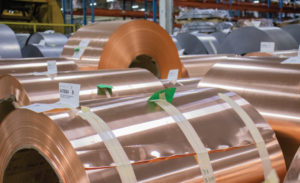Exploring the Diverse Applications of Copper Products in Modern Industries
Copper items have actually developed themselves as essential components across a myriad of modern sectors, primarily as a result of their impressive conductivity, malleability, and resistance to deterioration. From enhancing the efficiency of electrical systems to playing a critical role in renewable energy technologies, the adaptability of copper is obvious. In addition, its recyclability settings it as a lasting selection in manufacturing and electronic devices. As industries progressively focus on development and sustainability, the diverse applications of copper require a closer assessment, particularly concerning their prospective effect on future technological improvements and environmental methods.
Electrical Applications of Copper
Copper is a vital product in the electric sector, making up roughly 60% of the overall need for non-ferrous metals around the world - Copper Products. Its superior electrical conductivity, which is almost twice that of aluminum, makes it the favored selection for a broad variety of electric applications. From wiring systems in industrial and residential structures to high-voltage power transmission lines, copper ensures effectiveness and dependability in electrical energy delivery
Along with electrical wiring, copper is integral to the manufacturing of electrical elements such as transformers, motors, and generators. These elements take advantage of copper's thermal conductivity and pliability, important for warmth dissipation and efficient efficiency. Additionally, copper's resistance to rust boosts the lifespan and longevity of electrical systems, making it an affordable solution in the long term.
The growth of renewable resource resources, such as solar and wind power, has additionally raised the demand for copper in electrical applications. As sectors change towards lasting energy solutions, copper's role becomes even more essential. Overall, the convenience and performance attributes of copper strengthen its condition as a keystone material within the electric field, driving development and performance across numerous applications.
Plumbing and Piping Solutions
In modern-day pipes systems, the selection of products considerably influences both capability and durability. Copper has actually become a recommended alternative due to its one-of-a-kind residential properties, including corrosion resistance and antimicrobial features. These attributes make sure that copper piping remains sturdy and secure for moving potable water, an essential consideration in property and commercial applications.
Among the key benefits of copper in plumbing is its capacity to endure heats and pressures, making it ideal for a variety of applications, from hot water systems to heating and cooling networks. In addition, copper's versatility permits easier setup in intricate piping designs, lowering the threat of leakages and failings.
One more noteworthy benefit is copper's lengthy lifespan, commonly exceeding half a century with appropriate upkeep. This long life not only lessens replacement costs yet additionally adds to sustainable practices by decreasing waste. Moreover, copper's recyclability aligns with modern-day environmental criteria, promoting a circular economy within the pipes industry.
Copper in Renewable Resource
The adaptability of copper extends past plumbing applications, playing a vital role in the eco-friendly energy industry. In solar panels, copper is used in photovoltaic or pv cells my latest blog post and circuitry, promoting effective power conversion and transmission.

In addition, as the worldwide need for electric vehicles (EVs) boosts, copper's duty in battery systems and charging infrastructure ends up being a lot more significant. The material's ability to perform electrical energy successfully is indispensable to the efficiency of EV batteries, enhancing array and billing rate.
Copper's Function in Electronic devices
Electronics making depends greatly on copper's exceptional properties, especially its high electrical conductivity and thermal effectiveness. These features make copper an excellent selection for a variety of electronic elements, including ports, circuit card, and wiring. The metal's ability to successfully send electrical signals ensures very little energy loss, which is crucial in high-performance electronic gadgets.
In addition, copper's thermal conductivity plays a significant function in warm dissipation, safeguarding sensitive components from overheating. This is particularly essential in modern-day electronics, where compact styles cause enhanced heat generation. Copper is likewise favored for its pliability and ductility, permitting it to be quickly formed right into detailed designs that meet the demands of advanced electronic applications.
With the rise of customer electronics, telecommunications, and electric cars, the demand for copper in the electronic devices market continues to grow. As developments in modern technology progress, copper remains essential to attaining greater performance and dependability in digital items. Its recyclability additionally click resources enhances its appeal, as makers look for sustainable options without endangering high quality. Thus, copper continues to be a foundation material in the ever-expanding field of electronics.
Ingenious Uses in Production

One remarkable application is in additive manufacturing, where copper-based materials are employed in 3D printing procedures. This enables the creation of lightweight parts and complicated geometries, particularly in the aerospace and auto markets. Additionally, copper's thermal conductivity makes it a suitable option for warm exchangers, improving efficiency in commercial cooling systems.
Moreover, the increase of smart production has seen the unification of copper in IoT devices, where its conductive capacities sustain sophisticated noticing modern technologies. In the world of renewable resource, copper is pivotal in the production of photovoltaic panels and wind generators, facilitating extra effective energy conversion and circulation.
As industries pursue sustainability and innovation, copper's flexibility and efficiency useful source proceed to position it as a vital material, driving advancements in manufacturing and adding to the growth of smarter, more efficient items.
Verdict
In recap, copper products show remarkable adaptability throughout various modern-day sectors. Copper Products. Their remarkable conductivity boosts electric applications, while deterioration resistance guarantees dependability in plumbing. The integral function of copper in renewable resource and its vital function in electronic devices highlight its importance ahead of time sustainable practices. Furthermore, innovative usages in manufacturing emphasize copper's flexibility and sustaining importance. Jointly, these applications illustrate copper's essential payment to technical progress and industrial efficiency in modern culture.
From enhancing the effectiveness of electrical systems to playing a critical duty in sustainable energy technologies, the convenience of copper is apparent. As markets significantly focus on technology and sustainability, the diverse applications of copper require a closer evaluation, especially regarding their prospective impact on future ecological techniques and technological innovations.
The development of sustainable energy resources, such as solar and wind power, has better increased the need for copper in electrical applications. Overall, the flexibility and performance attributes of copper strengthen its condition as a cornerstone product within the electric market, driving technology and effectiveness across numerous applications.
The versatility of copper extends past plumbing applications, playing a vital function in the eco-friendly energy market.